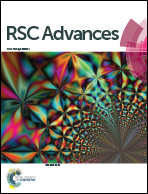Selective decolorization of cationic dyes by peroxymonosulfate: non-radical mechanism and effect of chloride†
Abstract
How to effectively activate oxidants like hydrogen peroxide (H2O2), peroxydisulfate (PDS) and peroxymonosulfate (PMS) is the focus of advanced oxidation processes (AOPs). In this study, we have found that PMS can directly decolorize cationic dyes without activation in a wide pH range (2.0–12.0). In addition, the presence of Cl− results in the formation of free available chlorine species and thus improves the degradation efficiency as well as broadening the scope of target pollutants. The first-order rate constant increased by 4.3 times when 2.5 mM Cl− was added as observed by an increase from 0.021 to 0.089 min−1, which further rose to 1.371 min−1 when Cl− was present at a level of 50 mM. Furthermore, it was found that only PMS has such an amazing effect while H2O2 and PDS do not. Radical quenching experiments and electron paramagnetic resonance (EPR) studies show that the decolorization of cationic dyes by PMS does not rely on the formation of sulfate radicals. A plausible mechanism is that cationic dyes (i.e., RhB+) first form a complex with the active component of PMS (HSO5−) owing to their electrical interaction. Subsequently, direct electron transfer from cationic dyes to HSO5− may occur and probably this is responsible for the bleaching of cationic dyes.


 Please wait while we load your content...
Please wait while we load your content...